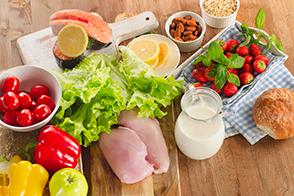
Patients with cancer experience a loss of appetite and a change in taste during treatment, especially chemotherapy. Here are some tasty and healthy tips provided by CPAA that can help you cope with treatment better even at higher doses.
A balanced diet for a patient must contain carbohydrates (bread, rice), proteins (meat, poultry, dal), fats (oil and butter), vitamins and fiber (fruits and vegetables). A typical daily diet should include 4 servings of cereals (1 bowl of rice/ 2 chapattis/ 1 slice of bread, nachani, jawar or bajra), 3 servings of proteins (2 oz meat/ 1 bowl whole dal), 2 servings of oil, 2 cups of milk and 4 servings of fruits and vegetables (1 bowl of vegetables, half a banana, 1 orange).
In general, there are no restrictions to what a patient can eat, but you should aim for a diet high in proteins and calorific value. It is important for those who are having difficulty eating, to have small and frequent meals so that the total intake is not reduced.
Tips to handle Loss of Appetite
During cancer treatment, patients experience a loss of appetite and a change in taste. Diet plays an important part in improving the ability of the patient to cope with treatment even at higher doses.
- Try to coax the patient's palate by changes in diet and including different items.
- Take advantage of days when there is an improvement in appetite.
- If the patient themselves are cooking, cook when you can and freeze the food to be eaten later.
- It has been observed that building a positive ambience, for example by the judicious use of colours, can help improve appetite.
- A change in scene, even another room in the house can make a difference.
- Avoid drinking liquids before and during meals unless absolutely necessary and then have milk instead of water.
- Always eat with your family.
- If you experience a feeling of fullness, have small but frequent meals, eat slowly, chew your food well and savour every bite.
- Avoid salads and clear soups which have no calories.
- Add cheese, mayonnaise, curd dressings and cream to enhance the nutritional value.
- Some patients find drinking colas, jal jeera, limejuice or having mild pickles and lemon helpful.
- Food should be served at room temperature.
- Distract yourself by reading books or watching TV while eating.
- In case these general measures do not relieve nausea, medicines can be taken 30-45 minutes before a meal. The patient should be told he is taking nausea controlling medication. This helps relieve symptoms psychologically.
Typical Diet Related Problems especially during Chemotherapy
Typical eating problems that are encountered are sore mouth, dry mouth, and change in taste, constipation, diarrhea, flatulence, nausea and reduced appetite.
Patients often experience a sore mouth due to chemotherapy or improper flow of saliva. For a sore mouth, avoid citrus juices. Have khichdi, bananas, soft paneer, and fresh curd (not sour). Avoid hard foods, or break them into small pieces. Use a straw when possible. Sucking on sweets, wetting bread or chapattis by dipping in dal or milk helps. Try pureeing food in a blender. Cold milk with Rose syrup helps for the soar mouth.
In case of diarrhea drink plenty of fluids. Rice kanji, noodles, boiled egg whites, bread, whey, arrow root and soups are good. Avoid food with high amounts of fiber like cauliflower and cabbage. To restore the sodium/potassium balance, the patient should be given Electoral, banana, apple and potato. Avoid milk, but have buttermilk, curds which have the lactose in a broken down form, which is easier to digest.
For constipation, increase the fiber content in your diet. Drink plenty of fluids through the day and a glass of hot water and honey just before bowel movement. Eat a lot of vegetables, liquidized if desired, but do not strain.
Dried ginger or ginger soaked in lemon juice or ajwain water can be taken to relieve flatulence. To prevent gas, avoid sprouted pulses; though they are a healthy source of proteins.
Boosting Nutrition
There are many commercially available formulas to boost nutrition. Some commonly used for cancer patients are Resource, Nutrocal, Glucema, Nutren, Ensure and Impact.
A special feed can also be made at home also which will boost nutrition -
- Add 50g wheat flour to 60ml oil or ghee and cook, then add 60g soya flour and cook further.
- Remove from the heat and add 25g moong dal, 100g carrot and 100g jaggery.
- Pressure cook this mixture and blend with a little water.
- This feed can be stored in the fridge and used whenever needed by diluting with water or mixing with dal or khichadi.
For people with diabetes, leave out the jaggery.
To increase nutritional value of any meal
- Add skim milk powder to curd, custard, desserts, soup, milk and gravies. (Once opened a skim milk packet must be stored in a tightly closed container).
- Add roasted and powdered nuts, chana dal or peanuts to porridge, shira, halwa.
- Add vegetables, paneer or moong dal to parathas.
- Mix moong dal and soya flour in the normal wheat flour.
- Boil milk down and reduce to ¼ or ½. and make basundi, rabri and kheer . This is also a good form of nutrition.
- Chicken stock and boiled chicken can be cooked ahead of time and kept in the freezer so that they are readily available when the patient feels hungry.
- Whenever the patient has juices, add glucose.
- Instead of plain rice, give a khichadi with dals and vegetables, cooked with excess water (3-4 times instead of 2).
- Flour of equal amounts of nachani, moong dal and lapsi (broken wheat) can be made by roasting each individually and grinding and a tasty porridge can be made of this flour. Pressure cooks this flour mix by adding milk, cardamom and saffron.
This article provided by Cancer Patients Aid Association (CPAA)







